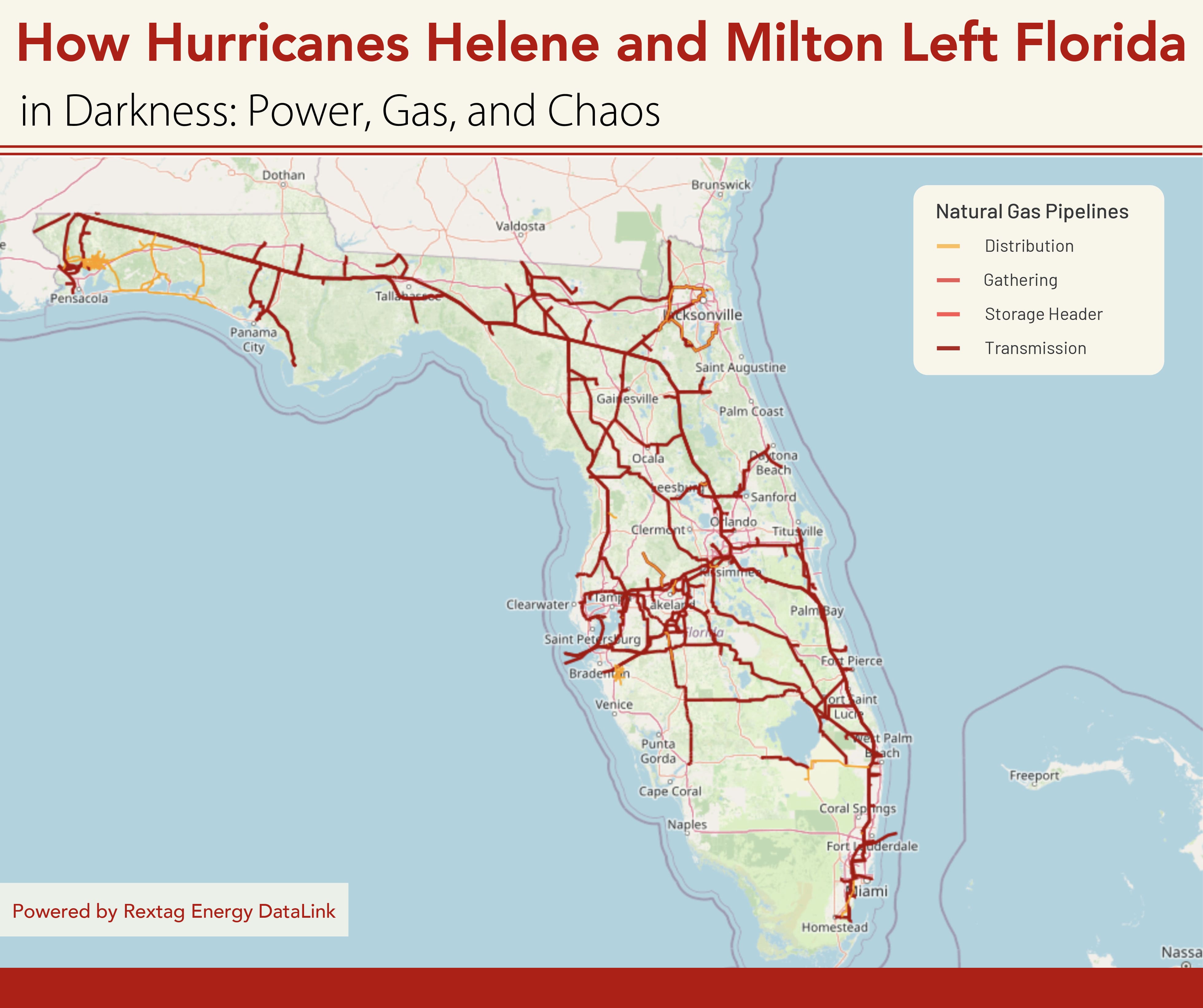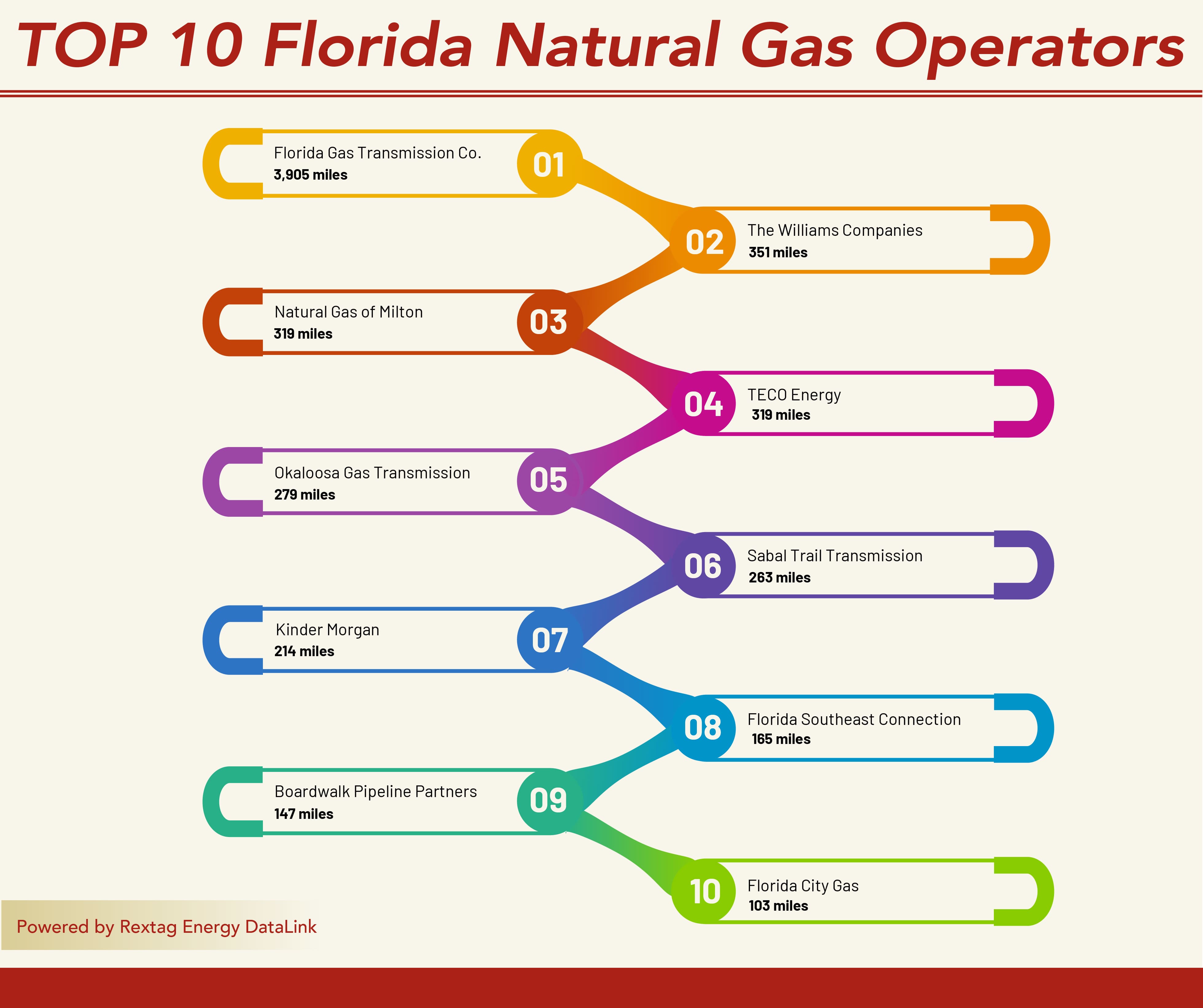Comprehensive Energy Data Intelligence
Information About Energy Companies, Their Assets, Market Deals, Industry Documents and More...
How Hurricanes Helene and Milton Left Florida in Darkness: Power, Gas, and Chaos
10/15/2024
The 2024 Atlantic hurricane season has hit Florida hard, with Hurricanes Helene and Milton exposing the vulnerabilities in the state's energy infrastructure. As Florida grapples with the aftermath of these back-to-back storms, the damage to oil, gas, and energy supplies has created severe disruptions, leaving residents and industries struggling to recover.
Florida’s Energy Dependency: A Vulnerable System Exposed
Florida is the third-largest gasoline consumer in the United States, yet it has no oil refineries. The state relies heavily on imports, with over 43% of its petroleum products, including gasoline, diesel, and jet fuel, flowing through Port Tampa Bay. Other major ports, like Port Everglades and Jacksonville, are equally vital to maintaining Florida’s energy supply chain. The state’s heavy reliance on waterborne imports and external refineries has made it particularly vulnerable to disruptions when natural disasters strike.
Panic Buying and Gasoline Supply Shortages
In the days leading up to Hurricane Milton’s landfall, panic buying gripped Florida as residents rushed to gas stations, causing widespread fuel shortages. By October 8, 2024, more than 15% of Florida’s gas stations had run out of fuel with the Tampa area reporting nearly 30% of stations dry. As evacuation orders were issued, Floridians stocked up on fuel for generators and vehicles, further straining the state’s already vulnerable gasoline supply chain.
As the storm approached, Kinder Morgan was forced to shut down its Central Florida Pipeline system, which carries gasoline, diesel, and jet fuel between Tampa and Orlando. The closure of the 10-inch and 16-inch lines, which had only recently resumed operation after Hurricane Helene, worsened the fuel shortages. Other key players, such as CITGO and Chevron, also halted operations at their Tampa terminals, making it nearly impossible for fuel to reach the hardest-hit areas.
Energy Infrastructure Shutdowns: Kinder Morgan and Beyond
Florida’s ports, including Port Tampa Bay, were closed to vessel traffic as Hurricane Milton moved closer to the coast, effectively cutting off the state’s fuel supply. Kinder Morgan's decision to shut down its Tampa terminal and Central Florida pipelines severely limited the distribution of refined products. Mansfield Energy declared a "Code Red" for Florida's fuel markets, requiring a 72-hour notice for new deliveries and warning that deliveries would come to a near halt as high winds made it unsafe for fuel trucks to operate.
Natural Gas Price Swings and Storage Overflow
Florida relies heavily on natural gas, which powers approximately 75% of the state’s electricity generation. As Hurricane Milton threatened to knock out power to millions, natural gas prices fell sharply. Traders anticipated a significant demand reduction, as power plants were forced offline, leaving an excess of natural gas that would otherwise be burned for electricity.
On October 9, U.S. natural gas futures dropped by 2.7%, driven by the expectation that power outages in major cities like Tampa and Orlando would leave large amounts of natural gas unburned. This gas surplus was diverted to storage facilities, which were already nearing capacity ahead of the winter months. Despite this temporary drop in prices, analysts expect the situation to stabilize as winter heating demand picks up, potentially leading to a rebound in prices.
Widespread Power Outages and Prolonged Fuel Shortages
By October 10, Hurricane Milton had knocked out power for over 1.4 million Florida residents, with the Tampa-St.Petersburg area was among the hardest hit. More than 77% of gas stations in the region were out of fuel, and state officials scrambled to address the deepening crisis. Florida Governor Ron DeSantis announced that 37.3 million gallons of fuel were being distributed from state reserves to meet the growing demand. Public fuel distribution sites were set up in cities like Plant City, Bradenton, and St. Petersburg, offering free gasoline to residents, but supplies remained limited.
The state’s ports faced significant operational challenges as well. While some, like Port Everglades and Miami, reopened under conditional restrictions, many ports remained closed, further delaying the arrival of fuel shipments. With power outages stretching across the state and gasoline shortages reaching critical levels, the recovery effort was expected to take weeks, if not months.
The Ripple Effect on Oil and Gas Production
In the Gulf of Mexico, Hurricanes Milton and Helene have had a lasting impact on oil and gas production. Helene had already reduced oil production by 30%, and Milton added further delays to the recovery process. Chevron evacuated its personnel from the Blind Faith oil platform, which has a production capacity of 65,000 barrels per day, as the storm passed through the region. Was projected that up to 50% of oil production in the Gulf could be shut down temporarily, adding to the growing list of supply chain disruptions.
These production shut-ins not only affect domestic supply but also have global implications, as the Gulf of Mexico is a significant source of both oil and natural gas exports. The storms have created bottlenecks in refining and shipping operations, leading to higher prices for crude oil and refined products on the global market.

If you are looking for more information about energy companies, their assets, and energy deals, please, contact our sales office mapping@hartenergy.com, Tel. 619-349-4970 or SCHEDULE A DEMO to learn how Rextag can help you leverage energy data for your business.
Exploring the Energy Lifeline: A Tour of Williston Basin's Midstream Infrastructure
![$data['article']['post_image_alt']](https://images2.rextag.com/public/blog/R-149 - Blog Exploring the Energy Lifeline_ A Tour of Williston Basin's Pipeline Infrastructure.png)
The Williston Basin, which spans parts of North Dakota, Montana, Saskatchewan, and Manitoba, is a major oil-producing region in North America. In order to transport crude oil and natural gas from the wells to refineries and other destinations, a vast pipeline infrastructure has been built in the area. The pipeline infrastructure in the Williston Basin consists of a network of pipelines that connect production sites to processing facilities, storage tanks, and major pipeline hubs
Breaking Barriers FireBird II, Empowered by Quantum Technology, Surpasses $500MM Funding Milestone for Permian Ventures
![$data['article']['post_image_alt']](https://images2.rextag.com/public/blog/147Blog_FireBird Energy Permian Basin assets.png)
Following the success of FireBird Energy's $1.75 billion sale to Diamondback last year, the emergence of FireBird II signals a new chapter in the Permian Basin. Get ready for some exciting news from the energy industry. FireBird Energy II, the new player in the Permian Basin, has just secured $500 million in equity funding to fuel their acquisitions. With backing from the esteemed private equity firm Quantum Energy Partners, FireBird Energy II is poised to make waves in the industry.
![$data['article']['post_image_alt']](https://images2.rextag.com/public/blog/328_Blog_Why Are Oil Giants Backing Away from Green Energy Exxon Mobil, BP, Shell and more .jpg)
As world leaders gather at the COP29 climate summit, a surprising trend is emerging: some of the biggest oil companies are scaling back their renewable energy efforts. Why? The answer is simple—profits. Fossil fuels deliver higher returns than renewables, reshaping priorities across the energy industry.
![$data['article']['post_image_alt']](https://images2.rextag.com/public/blog/327_Blog_Oil Market Outlook A Year of Growth but Slower Than Before.jpg)
The global oil market is full of potential but also fraught with challenges. Demand and production are climbing to impressive levels, yet prices remain surprisingly low. What’s driving these mixed signals, and what role does the U.S. play?
![$data['article']['post_image_alt']](https://images2.rextag.com/public/blog/326_Blog_USA Estimated Annual Rail CO2 Emissions 2035.jpg)
Shell overturned a landmark court order demanding it cut emissions by nearly half. Is this a victory for Big Oil or just a delay in the climate accountability movement?